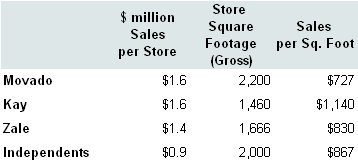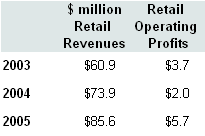IDEX Online Research: Profits Continue to Elude Movado Boutiques
April 11, 07
Rebuffing an institutional shareholder who had just called Movado’s boutique stores a “continuing albatross,” the company’s president and CEO Efrim Grinberg defended the company’s strategy to operate retail stores. The stores, he said, have done a “tremendous amount to build the Movado brand.” He continued, saying that what the stores have “done image-wise is invaluable.”
What brought about the disparaging comment from one of Movado’s institutional shareholders? Management had just told investors that the Movado boutiques would not be profitable at the 30-store level, a threshold it reached late last year, and that it could “be years” before the division is profitable.
Further, management said that the chain had just experienced a challenging year with same-store sales down in the holiday selling period. In addition, management outlined a plan to revitalize product development efforts and streamline costs. Finally, management said that two under-performing units would be closed this year.
While Movado executives offered several reasons for the disappointing financial results at its Movado boutique chain, IDEX Online Research believes that this is an excellent example of what happens when a manufacturer tries to enter the retail business.
It is difficult to find more than a handful of manufacturers who have successfully integrated their businesses all the way to retail in the U.S. market. The mentality and culture to operate at both the manufacturing level and the retail level seem to be mutually exclusive.
History of Movado Stores: Image-Building and Profitable
While the company has operated outlet stores for many years, it opened its first Movado boutiques (read “full price” stores) in the late 1990s. At the beginning of 1999, it operated four boutique stores (and 19 outlet stores).
At the time management opened the boutique units, it said that they would be beneficial to the company for two key reasons: 1) they would help raise recognition of the Movado brand; and, 2) they would eventually contribute to corporate profitability. Early proforma financial projections showed that the boutique chain could be profitable in the 22-25 store range, though that was pushed out to the 30-store level a couple of years ago.
In the fiscal year ended January 2006, Movado’s total retail operations – including 27 boutiques and 28 outlet stores – generated sales of $85.6 million, making it rank in the top 20 retail jewelers in America based on sales levels. Sales in the retail division in FYE 1/06 were up nearly 16 percent from the prior fiscal year. Movado does not provide revenue detail about sales levels in its boutiques versus its outlet units. However, IDEX Online Research believes that the Movado outlet stores and boutique stores generate about the same annual sales per store.
For the most recent fiscal year, management has not yet filed its year-end documents with the Securities & Exchange Commission, so much of the operating detail about the Movado stores has not yet become public information. However, management said that same-store sales in the boutique division were up a modest 2.3 percent versus last year’s gain of 8.5 percent.
Further, same-store sales in the all-important fourth quarter were down 1.8 percent. Total annual sales in the boutiques were up about 9 percent. In its outlet division, annual sales were up just over 1 percent. Revenues from the company’s retail division – boutiques and outlet stores – were an estimated $93 million in the most recent fiscal year ended January 2007, or about 17 percent of corporate revenues.
Movado Boutique Sales Productivity Below Average
Based on an average of about 57 stores operating during the most recent fiscal year and revenues of an estimated $93 million, Movado’s sales per store were a modest $1.6 million.
While this is well above the typical independent specialty jeweler which generates about $0.9 million per store in annual revenues, it is barely above the sales per store average of chain jewelers like Zale and Kay, who generate sales per store of $1.4 million and $1.6 million respectively. What makes Movado different is that its price points tend to be higher than those in a Kay or Zale store; thus, its sales per store should be notably higher.
Further, Movado boutiques are an average of 2,200 square feet, somewhat above the 2,000 square feet for an average independent jeweler, and well above the chain average of about 1,550 square feet per store. Its New York Soho store, which it is closing, is 4,700 square feet; its store in the Mall at Short Hills (NJ) is 3,200 square feet; all other stores are close to the corporate average. Its outlet stores are an average of 1,600 square feet in size.
The table below summarizes sales productivity for the Movado retail operation – boutiques and outlet stores – versus others in the industry.
Movado Retail

What does this mean? Movado’s sales productivity per square foot is below average, and its sales per store are below expectations.
Management’s Explanation: Disappointing Sales
Management cited several reasons that the Movado retail boutiques are not profitable, including the following:
- Disappointing sales levels – Based on our sales productivity analysis, these stores should be producing sales of $2-3 million per year as a result of their higher-end position in the market, their size, and their product mix.
- Missing price points – The company has moved away from some of its lower price points. For example, its opening price points for sterling silver jewelry have moved up, perhaps too high. In addition, its key price points for diamond fashion – 18 karat gold with diamond accents – have moved up to $1,500-3,000 from the former level of $1,000-2,000. While lower opening price points might bring down the average ticket, the stores probably lost sales to shoppers who were turned off by high prices.
- Unfocused designs – Movado president Grinberg said the boutiques “got a little unfocused” in the second half of the year. Management says that today’s consumers want a “modern” design, whether it is jewelry, watches, or furniture; unfortunately, Movado initially missed this trend in 2006.
Management noted that its store sales mix was roughly 40 percent watches, 43 percent jewelry, and 17 percent gifts and services. Assuming that Movado transfers its watches to the boutiques at the same price as it sells its watches to other retailers, that may explain why profits are slow in coming: watches typically carry among the lowest margins of any product category in a jewelry store.
Watch sales in the typical independent jeweler’s store represent only about 10 percent of total sales at a 44 percent gross margin versus a store average of a 50 percent gross margin.
In response to a question from an investor about the possibility of a management change at the Movado boutique chain, Grinberg said that he was streamlining management in an effort to increase efficiency and reduce costs. Further, he said that he and his executive team were spending a lot of his time focusing on the Movado boutique operation.
Despite the challenges in the Movado boutique division, management plans to open two stores in 2007, and should end the year with 31 units.
In addition to the New York Soho store which is closing, management plans to close a Movado boutique in North Brook, a suburb of Chicago. Management characterized both stores as “under-performing”, and said it could close the stores at virtually no cost.
How Unprofitable Are the Boutiques?
Despite management’s claim that it could be “years” before the boutiques are profitable, we suspect that perhaps they spoke in haste. The context of this comment appeared to come from an unscripted portion of their speech.
Management said that the boutiques were profitable on a “four-wall” basis. Thus, total sales levels are not high enough to leverage infrastructure expense and generate profitability.
Here is an analysis of profitability from all retail store operations, which the company provided in a legal filing last year. Movado Retail

Based on this information, it is clear that the Movado outlet stores are profitable. Frankly, it would come as no surprise if the company said its outlet stores were not profitable; they primarily serve as a controlled dumping ground for discontinued merchandise.
Thus, the answer to “how unprofitable are the boutiques?” is “not very.” In other words, they must be on the cusp of profitability. Perhaps management will surprise us in the current fiscal year.